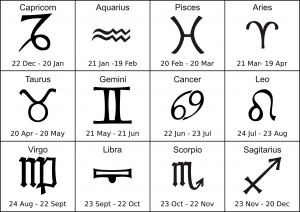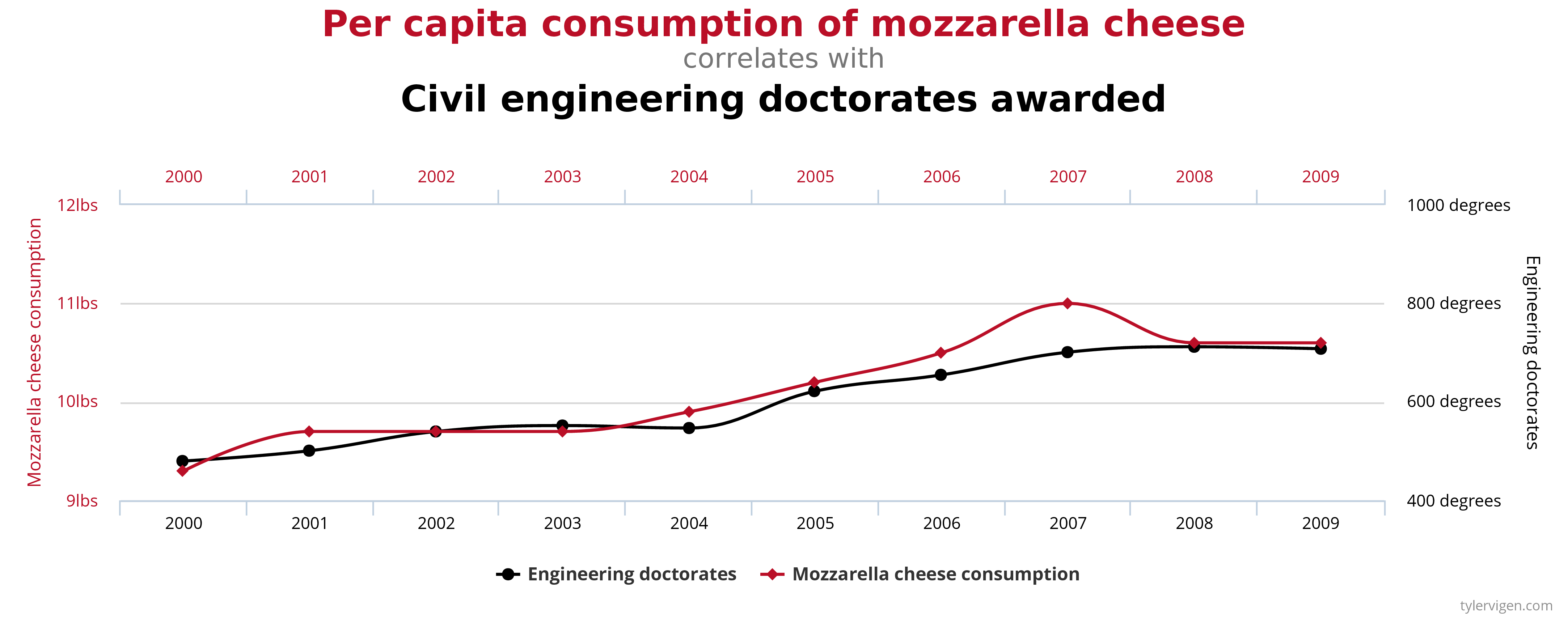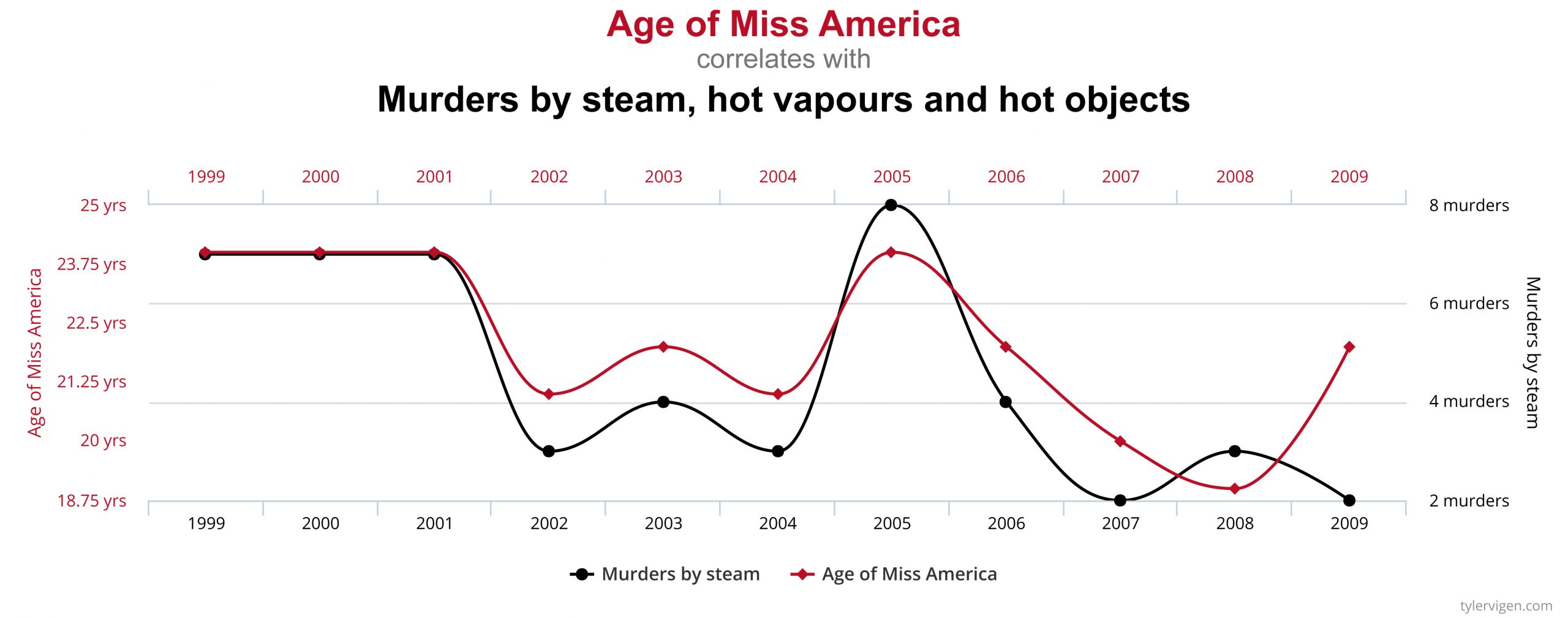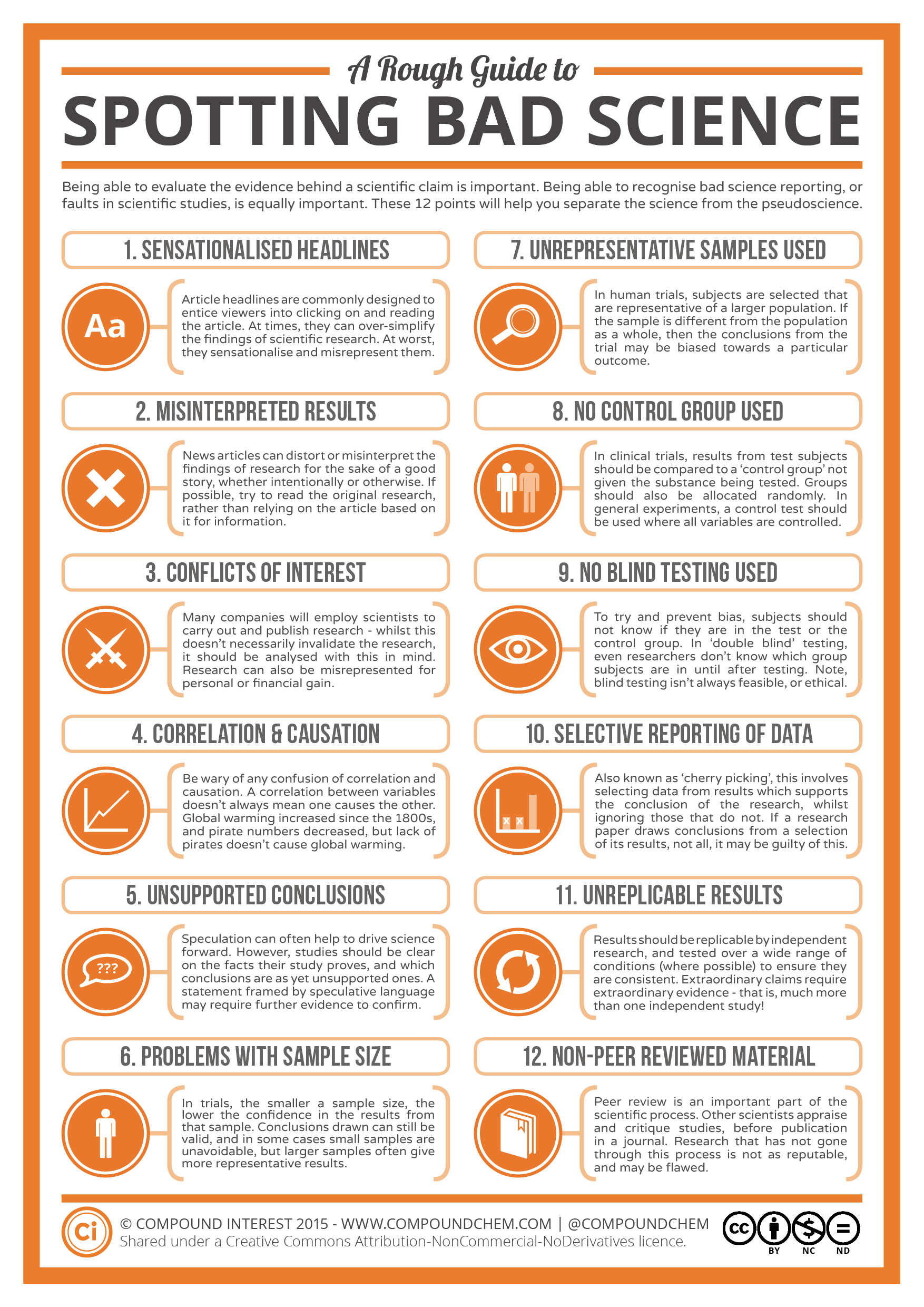6 1.7 Pseudoscience and Other Misuses of Science
Created by: CK-12/Adapted by: Christine Miller
What Is Pseudoscience?
Pseudoscience is a claim, belief, or practice that is presented as scientific but does not adhere to the standards and methods of science. True science is based on repeated evidence-gathering and testing of falsifiable hypotheses. Pseudoscience does not adhere to these criteria. In addition to phrenology, some other examples of pseudoscience include astrology, extrasensory perception (ESP), reflexology, reincarnation, and Scientology,
Characteristics of Pseudoscience
Whether a field is actually science or just pseudoscience is not always clear. However, pseudoscience generally exhibits certain common characteristics. Indicators of pseudoscience include:
- The use of vague, exaggerated, or untestable claims: Many claims made by pseudoscience cannot be tested with evidence. As a result, they cannot be falsified, even if they are not true.
- An over-reliance on confirmation rather than refutation: Any incident that appears to justify a pseudoscience claim is treated as proof of the claim. Claims are assumed true until proven otherwise, and the burden of disproof is placed on skeptics of the claim.
- A lack of openness to testing by other experts: Practitioners of pseudoscience avoid subjecting their ideas to peer review. They may refuse to share their data and justify the need for secrecy with claims of proprietary or privacy.
- An absence of progress in advancing knowledge: In pseudoscience, ideas are not subjected to repeated testing followed by rejection or refinement, as hypotheses are in true science. Ideas in pseudoscience may remain unchanged for hundreds — or even thousands — of years. In fact, the older an idea is, the more it tends to be trusted in pseudoscience.
- Personalization of issues: Proponents of pseudoscience adopt beliefs that have little or no rational basis, so they may try to confirm their beliefs by treating critics as enemies. Instead of arguing to support their own beliefs, they attack the motives and character of their critics.
- The use of misleading language: Followers of pseudoscience may use scientific-sounding terms to make their ideas sound more convincing. For example, they may use the formal name dihydrogen monoxide to refer to plain old water.
Persistence of Pseudoscience
Despite failing to meet scientific standards, many pseudosciences survive. Some pseudosciences remain very popular with large numbers of believers. A good example is astrology.
Astrology is the study of the movements and relative positions of celestial objects as a means for divining information about human affairs and terrestrial events. Many ancient cultures attached importance to astronomical events, and some developed elaborate systems for predicting terrestrial events from celestial observations. Throughout most of its history in the West, astrology was considered a scholarly tradition and was common in academic circles. With the advent of modern Western science, astrology was called into question. It was challenged on both theoretical and experimental grounds, and it was eventually shown to have no scientific validity or explanatory power.

Today, astrology is considered a pseudoscience, yet it continues to have many devotees. Most people know their astrological sign, and many people are familiar with the personality traits supposedly associated with their sign. Astrological readings and horoscopes are readily available online and in print media, and a lot of people read them, even if only occasionally. About a third of all adult Americans actually believe that astrology is scientific. Studies suggest that the persistent popularity of pseudosciences such as astrology reflects a high level of scientific illiteracy. It seems that many Americans do not have an accurate understanding of scientific principles and methodology. They are not convinced by scientific arguments against their beliefs.
Dangers of Pseudoscience
Belief in astrology is unlikely to cause a person harm, but belief in some other pseudosciences might — especially in health care-related areas. Treatments that seem scientific but are not may be ineffective, expensive, and even dangerous to patients. Seeking out pseudoscientific treatments may also delay or preclude patients from seeking scientifically-based medical treatments that have been tested and found safe and effective. In short, irrational health care may not be harmless.
Scientific Hoaxes, Frauds, and Fallacies
Pseudoscience is not the only way that science may be misused. Scientific hoaxes, frauds, and fallacies may misdirect the pursuit of science, put patients at risk, or mislead and confuse the public. An example of each of these misuses of science and its negative effects is described below.
The Piltdown Hoax
![Image by By James Howard McGregor [Public domain], via Wikimedia Commons A side profile view of an artists rendition of what the Piltdown Man may have looked like, had he been real.](https://jwu.pressbooks.pub/app/uploads/sites/31/2021/05/Piltdown-Man-300x285.jpg)
Piltdown Man (see picture left) was a paleontological hoax in which bone fragments were presented as the fossilized remains of a previously unknown early human. These fragments consisted of parts of a skull and jawbone, reported to have been found in 1908 in a gravel pit at Piltdown, East Sussex, England. The significance of the specimen remained the subject of controversy until it was exposed in 1953 as a hoax. It eventually came to light that the specimen consisted of the lower jawbone of an orangutan deliberately combined with skull bones of a modern human. The Piltdown hoax is perhaps the most infamous paleontological hoax ever perpetrated, both for its impact on the direction of research on human evolution and for the length of time between its “discovery” and its full exposure as a forgery.
![Photo by Anrie [CC BY-SA 3.0 (https://creativecommons.org/licenses/by-sa/3.0)], from Wikimedia Commons A replica of the infamous Piltdown skull. The skull is encased in a glass sphere. The replica shows portions of the skull which were bone in white, and the portions of the skull which were inferred in black.](https://jwu.pressbooks.pub/app/uploads/sites/31/2021/05/Sterkfontein_Piltdown_man-300x294.jpg)
In 1912, the head of the geological department at the British Museum proposed that Piltdown man represented an evolutionary missing link between apes and humans. With its human-like cranium and ape-like jaw, it seemed to support the idea then prevailing in England that human evolution began with the brain. The Piltdown specimen led scientists down a blind alley in the belief that the human brain increased in size before the jaw underwent size reductions to become more like the modern human jaw. This belief confused and misdirected the study of human evolution for decades, and actual fossils of early humans were ignored because they didn’t support the accepted paradigm.
The Vaccine-Autism Fraud
You may have heard that certain vaccines put the health of young children at risk. This persistent idea is not supported by scientific evidence or accepted by the vast majority of experts in the field. It stems largely from an elaborate medical research fraud that was reported in a 1998 article published in the respected British medical journal, The Lancet. The main author of the article was a British physician named Andrew Wakefield. In the article, Wakefield and his colleagues described case histories of 12 children, most of whom were reported to have developed autism soon after the administration of the MMR (measles, mumps, rubella) vaccine.
Several subsequent peer-reviewed studies failed to show any association between the MMR vaccine and autism. It also later emerged that Wakefield had received research funding from a group of people who were suing vaccine manufacturers. In 2004, ten of Wakefield’s 12 coauthors formally retracted the conclusions in their paper. In 2010, editors of The Lancetretracted the entire paper. That same year, Wakefield was charged with deliberate falsification of research and barred from practicing medicine in the United Kingdom. Unfortunately, by then, the damage had already been done. Parents afraid that their children would develop autism had refrained from having them vaccinated. British MMR vaccination rates fell from nearly 100 per cent to 80 per cent in the years following the study. The consensus of medical experts today is that Wakefield’s fraud put hundreds of thousands of children at risk because of the lower vaccination rates and also diverted research efforts and funding away from finding the true cause of autism.
Correlation-Causation Fallacy
Many statistical tests used in scientific research calculate correlations between variables. Correlation refers to how closely related two data sets are, which may be a useful starting point for further investigation. Correlation, however, is also one of the most misused types of evidence, primarily because of the logical fallacy that correlation implies causation. In reality, just because two variables are correlated does not necessarily mean that either variable causes the other.
A few simple examples, illustrated by the graphs below, can be used to demonstrate the correlation-causation fallacy. Assume a study found that both per capita consumption of mozzarella cheese and the number of Civil Engineering doctorates awarded are correlated; that is, rates of both events increase together. If correlation really did imply causation, then you could conclude from the second example that the increase in age of Miss America causes an increase in murders of a specific type or vice versa.


An actual example of the correlation-causation fallacy occurred during the latter half of the 20th century. Numerous studies showed that women taking hormone replacement therapy (HRT) to treat menopausal symptoms also had a lower-than-average incidence of coronary heart disease (CHD). This correlation was misinterpreted as evidence that HRT protects women against CHD. Subsequent studies that controlled other factors related to CHD disproved this presumed causal connection. The studies found that women taking HRT were more likely to come from higher socio-economic groups, with better-than-average diets and exercise regimens. Rather than HRT causing lower CHD incidence, these studies concluded that HRT and lower CHD were both effects of higher socio-economic status and related lifestyle factors.
Check out this “Rough Guide to Spotting Bad Science” infographic from Compound Interest:

1.7 Summary
- Pseudoscience is a claim, belief, or practice that is presented as scientific, but does not adhere to scientific standards and methods.
- Indicators of pseudoscience include untestable claims, lack of openness to testing by experts, absence of progress in advancing knowledge, and attacks on the motives and character of critics.
- Some pseudosciences, including astrology, remain popular. This suggests that many people do not possess the scientific literacy needed to distinguish pseudoscience from true science, or to be convinced by scientific arguments against them.
- Belief in a pseudoscience such as astrology is unlikely to cause harm, but belief in pseudoscientific medical treatments may be harmful.
- In addition to pseudoscience, other examples of the misuse of science include scientific hoaxes (such as the Piltdown hoax), scientific frauds (such as the MMR vaccine-autism fraud), and scientific fallacies (such as the correlation-causation fallacy).
1.7 Review Questions
- Define pseudoscience. Give three examples.
- What are some indicators that a claim, belief, or practice might be pseudoscience rather than true science?
- Astrology was once considered a science, and it was common in academic circles. Why did its status change from a science to a pseudoscience?
- What are possible reasons that some pseudosciences remain popular even after they have been shown to have no scientific validity or explanatory power?
- List three other ways besides pseudoscience that science can be misused, and identify an example of each.
- Explain how misuses of science may waste money and effort. How can they potentially cause harm to the public?
- Many claims made by pseudoscience cannot be tested with evidence. From a scientific perspective, why is it important that claims be testable?
- What do you think is the difference between pseudoscience and belief?
- If you see a website that claims that an herbal supplement causes weight loss and they use a lot of scientific terms to explain how it works, can you be assured that the drug is scientifically proven to work? If not, what are some steps you can take to determine whether or not the drug does in fact work?
- Why do you think it was problematic that Andrew Wakefield received funding from a group of people who were suing vaccine manufacturers?
- What do you think it says about the 1998 Wakefield paper that ten of the 12 coauthors formally retracted their conclusions?
1.7 Explore More
How to spot a misleading graph – Lea Gaslowitz, TED-Ed, 2017.
How statistics can be misleading – Mark Liddell, TED-Ed, 2016.
Attributions
Figure 1.7.1
Zodiac Signs Cancer Aquarius Aries Gemini Leo from Max Pixel, is used under a CC0 1.0 Universal Public Domain Dedication license (https://creativecommons.org/publicdomain/zero/1.0/deed.en).
Figure 1.7.2
Piltdown Man – McGregor model, by James Howard McGregor on Wikimedia Commons is in the public domain (https://en.wikipedia.org/wiki/Public_domain).
Figure 1.7.3
Sterkfontein Piltdown man, by Anrie on Wikimedia Commons is used under a CC BY-SA 3.0 (https://creativecommons.org/licenses/by-sa/3.0) license.
Figure 1.7.4
Spurious Correlations (Causation Fallacy) – Consumption of mozzarella cheese and awarded Doctorates by Tyler Vigen on Tylervigen.com is used under a CC BY 4.0 (https://creativecommons.org/licenses/by/4.0/) license.
Figure 1.7.5
Spurious Correlations (Causation Fallacy) – Miss America and Murder, by Tyler Vigen, is used under a CC BY 4.0 (https://creativecommons.org/licenses/by/4.0/) license.
Figure 1.7.6
A rough guide to spotting bad science, by Compound Interest, is used under a CC BY-NC-ND 2.0 (https://creativecommons.org/licenses/by-nc-nd/2.0/ca/) license
References
TED-Ed. (2017, July 6). How to spot a misleading graph – Lea Gaslowitz. YouTube. https://www.youtube.com/watch?v=E91bGT9BjYk&feature=youtu.be
Wakefield, A.J., Murch, S.H., Anthony, A., Linnell, J., Casson, D.M., Malik, M., et al. (1998). Ileal-lymphoid-nodular hyperplasia, non-specific colitis, and pervasive developmental disorder in children. Lancet, 351: 637–41.
Wikipedia contributors. (2020, June 18). Andrew Wakefield. Wikipedia. https://en.wikipedia.org/w/index.php?title=Andrew_Wakefield&oldid=963243135
A collection of beliefs or practices mistakenly regarded as being based on scientific method.
An intentional deception for the purpose of humour or malice.

